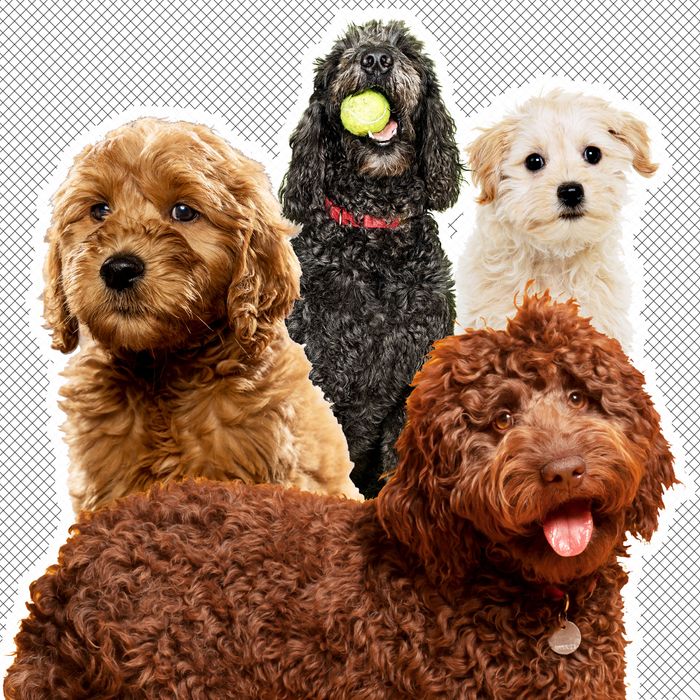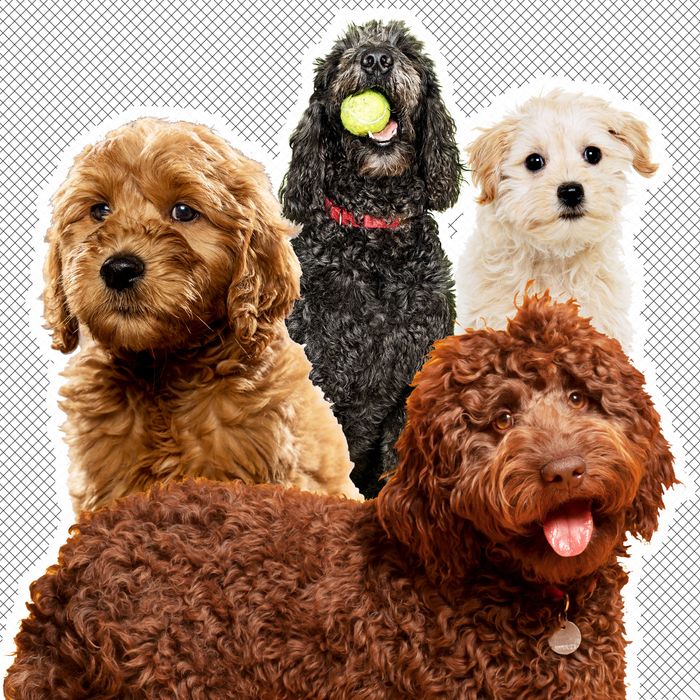

You can find one-year-old Ruby Schwartz ambling along a certain stretch of Seventh Avenue in Park Slope each morning, greeting every person, place, and thing with a giant smile and a warm hug. Ruby is gentle, hopelessly friendly, and perpetually shaggy, but she’s hardly unique. Ruby is a dog, by the way. A floppy-haired, cinnamon-colored cockapoo (that’s a cocker spaniel and poodle mix) who happens to look remarkably like a Pickles, and a Cooper, and an Ozzie, and a Loki, and a Bronzely, and a Roti, and a Snoopy, and a Shelby, and a Winnie, and of course a Ginger — all real, similarly bred dogs belonging to my neighbors, who’ve brought them home seemingly simultaneously sometime within the past few years. An entirely adorable invasive species, if you will.
Look around the park, the farmers’ market, the sidelines of the suburban soccer field — anywhere, really; it’s impossible not to notice that they’re everywhere and there are so many of them. A button-nosed stuffed animal en vivo! The modern-farmhouse look of dog breeds: approachable, easygoing, bougie. (For the record: I, too, love them and may or may not secretly want one, because I am human.)
A “doodle” is a dog that is part purebred poodle, part something else. Popular combos include the Labradoodle (Labrador retriever and poodle), the goldendoodle (golden retriever and poodle), the Bernedoodle (Bernese mountain dog and poodle), the sheepadoodle (sheepdog and poodle), the Cavapoo (Cavalier King Charles spaniel and poodle), and the Australian Labradoodle (Labrador retriever, poodle, and cocker spaniel). “There’s pretty much any combo you can think of these days,” says Shelby Semel, a New York City–based canine-behavior expert and trainer. “As we’ve seen dog ownership go up overall, we’ve also seen a huge increase in doodle dogs specifically.”
The first doodles were bred in the ’80s in Australia by a man named Wally Conron, who was hoping to create a guide dog for a blind woman whose husband was allergic to dogs. Conron wanted all the highly desirable traits of the poodle — who don’t shed and are therefore less likely to cause discomfort for those who are allergic, and who are also considered intelligent and athletic — while adding in some qualities of other breeds that people have come to adore: the easygoing, affable Lab; the sweet, faithful golden; the beautiful, mellow Bernese.
Even better, a doodle has none of the obvious “poodleness” like the froufrou “show dog” haircut or the perception that they’re high-strung and high-maintenance.
The trouble is some doodles do shed to some degree or another, and any breeder who tells you the puppy they’re selling 100 percent for sure won’t drop a hair isn’t being truthful, says Karen, a co-founder of the nationwide doodle organization Doodle Rescue Collective who requested we not include her last name, and who for the past decade and a half has helped rehome hundreds of doodle dogs in the Chicago area, many of whom come her way after owners found that their dogs shedded more than they wanted.
“There is not actually one specific gene for shedding, although there are a few other coat-related genes that breeders look at as sort of proxy markers,” she says. “So it’s always going to be a gamble. To me, saying a dog is ‘low shedding’ is kind of like ‘a little bit pregnant.’”
There’s no such thing as a completely “hypoallergenic” dog, says Jodi Novak, a veterinarian in Altamont, New York, because all dogs of every breed have dander (a.k.a. doggy dandruff, or flakes of skin) and saliva, both of which contain the protein that can prompt allergies. Poodles don’t shed (and aren’t excessively drooly), but their dander is much more likely to stay trapped next to their skin as opposed to strewn in hair all over your home or clothes, as happens with shedding dogs. While some folks can adapt to a lifestyle that involves popping a daily Claritin, others have more severe allergies that can make it a miserable situation. “Unfortunately, this misconception is often perpetuated by unscrupulous sellers profiting from unassuming optimism.”
For his part, Conron has famously said he regrets having opened a “Pandora’s box” that inadvertently kicked off a crossbreeding frenzy. He’s claimed that most of today’s mopheads are “crazy” or have a “hereditary problem.” While that’s probably an exaggeration, some doodles can be a handful, says Semel, which is a large part of why so many people want one — and why they reconsider that decision. “High-energy dogs tend to be athletic dogs who need quite a bit of exercise, and I think some people underestimate this. The poodle genes bring them brains and the desire to work and do fun tricks and be mentally stimulated. If they don’t have that, they can start to display anxiety and just act nutty.” Kelly Ballantyne, a veterinary behaviorist at Insight Animal Behavior Services in Chicago, says she has seen a ton of doodles lately, “mostly for separation anxiety, noise phobia, and aggression issues.” Ballantyne points to a recent study that found that first-generation goldendoodles in particular displayed more problematic behaviors than either parent breed.
While there are no statistics on exactly how many doodles are adopted every year, pet ownership overall has been soaring, especially during the pandemic. According to the American Society for the Prevention of Cruelty to Animals, more than 23 million American households — nearly one in five nationwide — adopted a pet during the pandemic. And the demand for doodles has definitely grown as evidenced by the prices for doodle puppies, which range from $2,000 to $5,000 in some areas and for certain kinds. “Before the pandemic, I would get maybe five to ten requests a day about puppies,” says Lisa Haney, who breeds Cavapoos in Western New York. “But during the pandemic, it’s been more like 75 to 100 emails a day. I literally had people calling me at 3 a.m. to ask about puppies.”
As a result, doodles have become what one sheepish goldendoodle owner called “the pumpkin spice of dogs” (wildly popular but oversaturated and, according to some, overrated). Ruby’s owner, Lisa Schwartz, certainly didn’t think doodles were “edgy and cool,” but she does believe “there’s a reason everyone wants one: She doesn’t shed, she isn’t anxious, she’s great in the car, she trains easily, she’s sweet and friendly.” In short: “Ruby has really adapted to our lifestyle.” ”
“I’ll be honest: It does feel embarrassing to walk around with a ‘designer’ dog,” says Anne, a teacher in Brooklyn whose name isn’t really Anne and who just brought home a $3,500 Australian Labradoodle two months ago. “And to know we went with a breeder rather than rescue a dog who needs a home! I find myself explaining to every single person that we would have gotten a rescue if I wasn’t allergic and that there were other factors that made a doodle seem ‘right’ for our ‘lifestyle,’ which feels … obnoxious.” (Plus her vet recently informed her that the new pup will likely be twice the size promised to them, a 30-pound jump.)
The sudden uptick in the doodle population has created a loose head nod of a community of those who have opted for a doodle or feel like they are on a parallel canine journey. “Now we are connected with all these fellow doodle people we see on the street and in the park — and there are so many of them,” Anne tells me. “But what do we really have in common? Like we are in a whole subcommunity now, but are these really my people? I feel like I am a rescue-dog owner trapped in the body of a doodle owner.”
Not that being a rescue-doodle owner is actually an option for most. “When one comes into the shelter, it’s insane,” says Tiffany Lacey, the executive director of Animal Haven in New York City. “We have had doodles who have had over 100 inquiries in just a few hours and 50 applications.”
And with the vast majority of breeders using search- and sneeze-friendly terms such as “the perfect family dog,” “hypoallergenic,” and “no shedding,” it’s hard not to get swept up in the fervor and want to bring one home. Shari, a doodle owner in Toronto, thought she asked “all the right questions” of her breeder, but her eight-year-old goldendoodle sheds and has prompted allergic reactions in herself and several other people. (Thankfully, her allergies eventually abated.) “I believe my breeder believed what she shared with me, but I think breeders don’t always understand the dogs they are breeding,” she says.
A lot of misinformation about doodles and overzealous marketing is fueling the doodle boom. “Doodles aren’t ‘different’ than other dogs,” says Adina Pearson, who runs the doodle information and appreciation website Doodle Kisses and hosts a podcast of the same name. “They bark, they poop, many of them shed, they have health issues like their breed parents, and they need training.” The problem is in perception, says Pearson — the perception that they are an exception to so many of these problems. (Pearson currently has a Labradoodle and a poodle.)
At the end of the day, “even if they spent $4,000 on a dog that is twice the size and sheds, most people will brush over the mistake with the halo of love,” says Pearson. “That’s what we all hope people will do, whether it’s a mangy mutt from a stinky shelter or the offspring of a champion-bred standard poodle.”